网络基础¶
协议模型¶
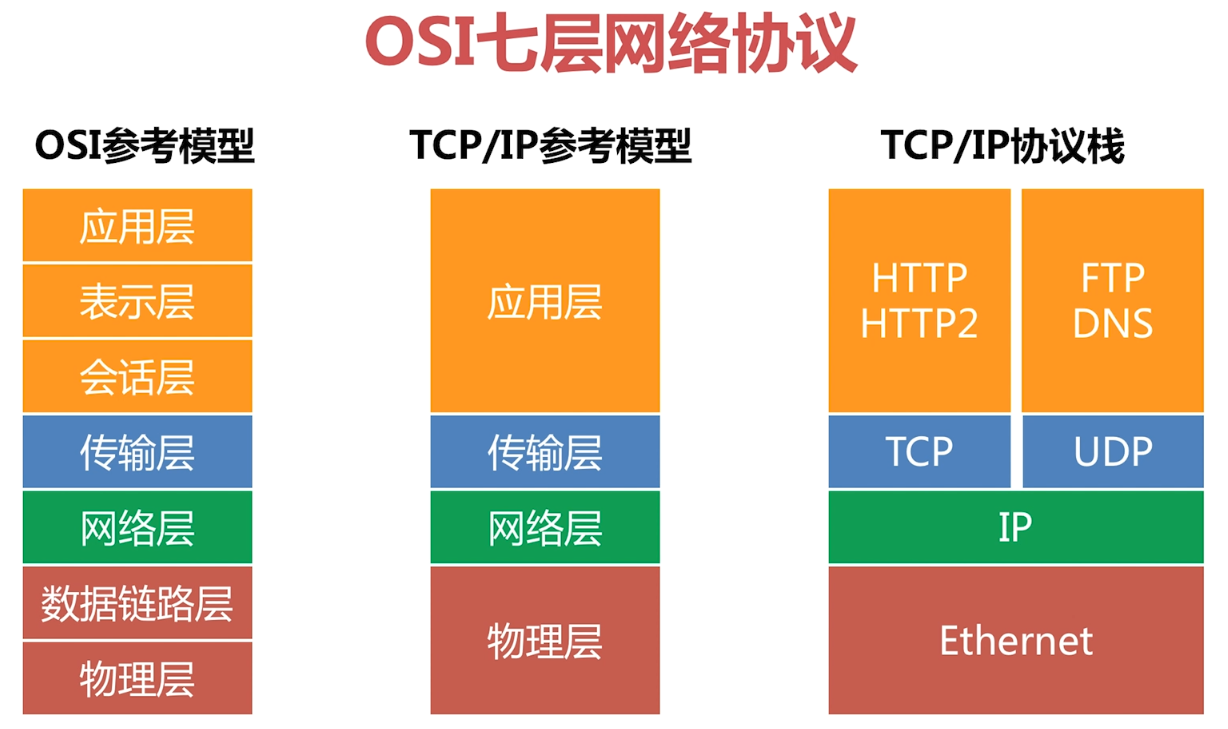
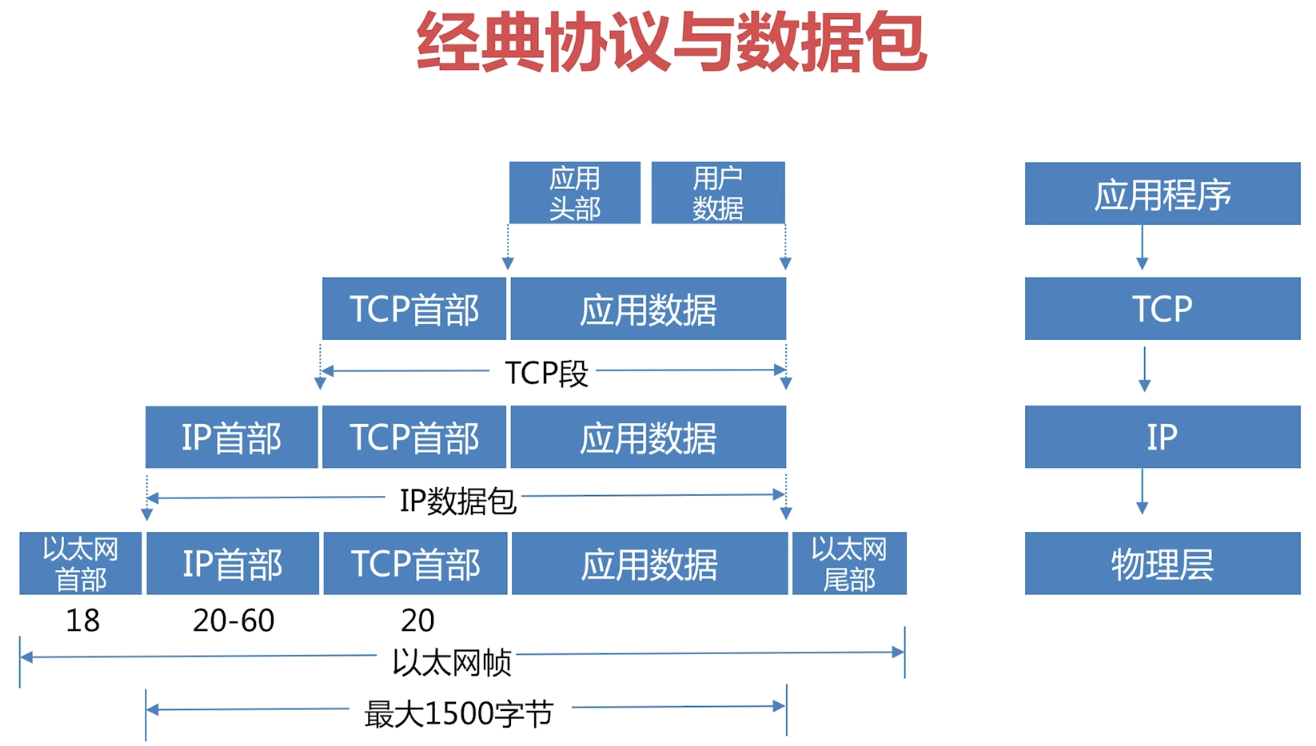
TCP连接¶
TCP的三次握手最主要目的是保证连接是双工的,可靠更多的是通过重传机制来保证。因为连接是全双工的,双方必须都收到对方的FIN包及确认才可关闭。
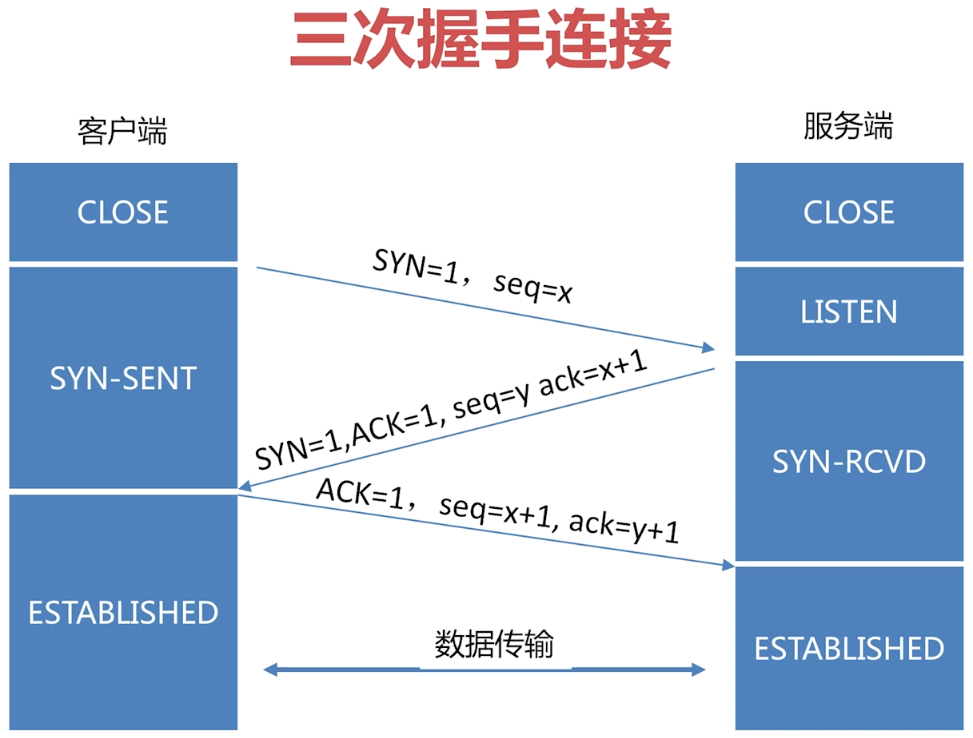
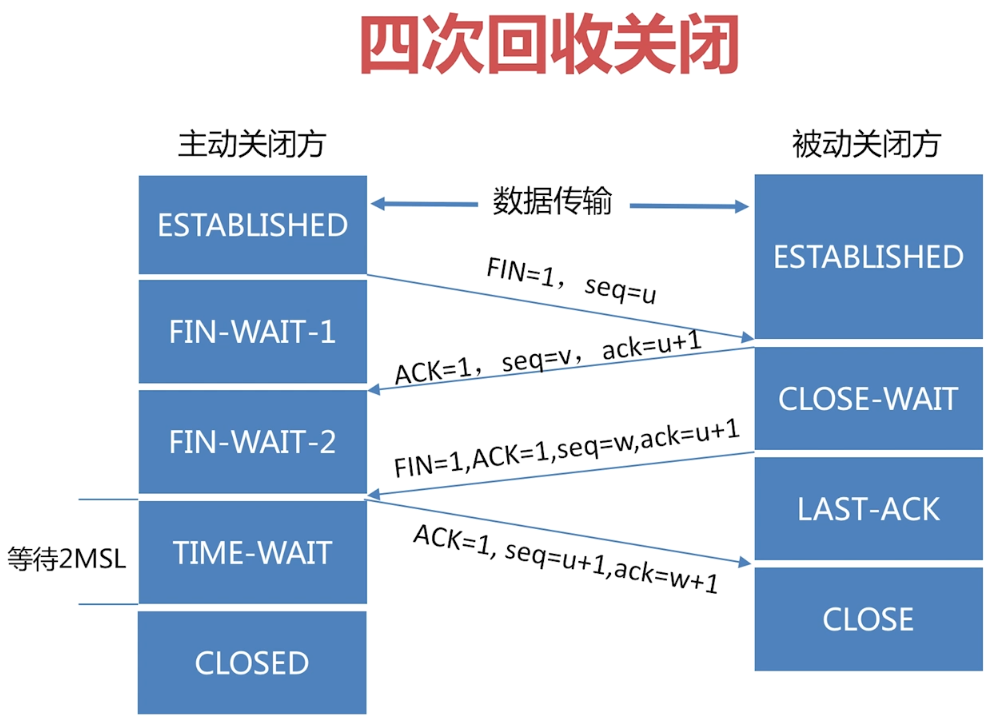
MSL:Maximum Segment Lifetime,30秒到1分钟。
TIME-WAIT等待2MSL是保证TCP协议的全双工连接能够可靠关闭。保证这次连接的重复数据段从网络中消失。
大量出现close_wait的原因:
- 一般出现在被动关闭方
- 并发请求太多导致
- 被动关闭方未及时释放端口资源导致
TCP流量控制¶
由于通讯双方,网速不同。通讯方任一方发送过快都会导致对方消息处理不过来,所以就需要把数据放在缓冲区中。如果缓冲区满了,发送方还在发送,那接收方只能把数据包丢弃。因此需要控制发送速率。
缓冲区大小称之为接收端口,用变量win表示。如果win=0,则发送方停止发送。
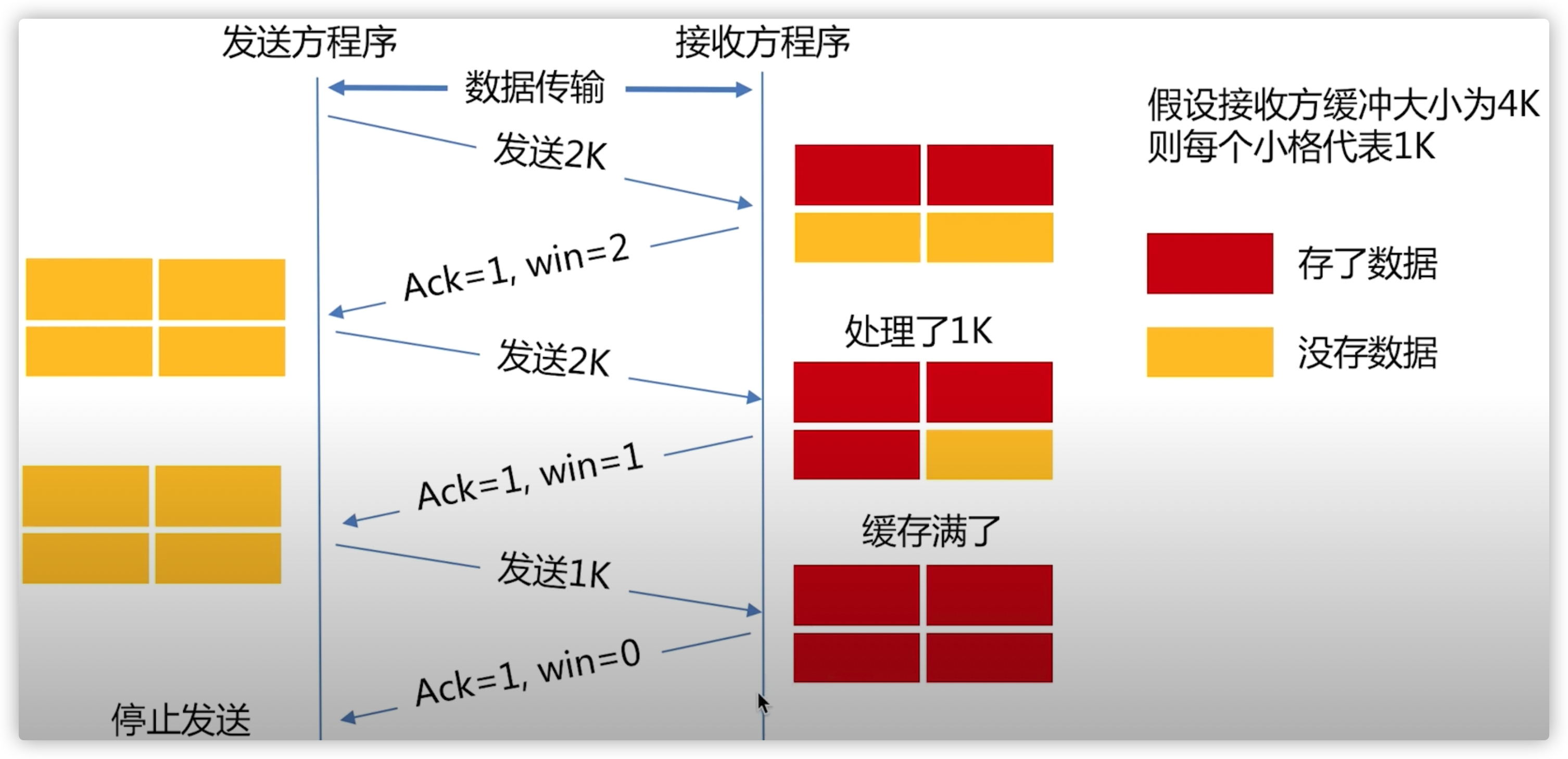
TCP拥塞控制¶
拥塞控制是调节网络的负载。接收方网络资源繁忙,因未及时响应ACK导致发送方重传大量数据,这样将会导致网络更加拥堵。拥塞控制是动态调整win大小,不知是依赖缓冲区大小确定窗口大小。
慢开始和拥塞避免¶
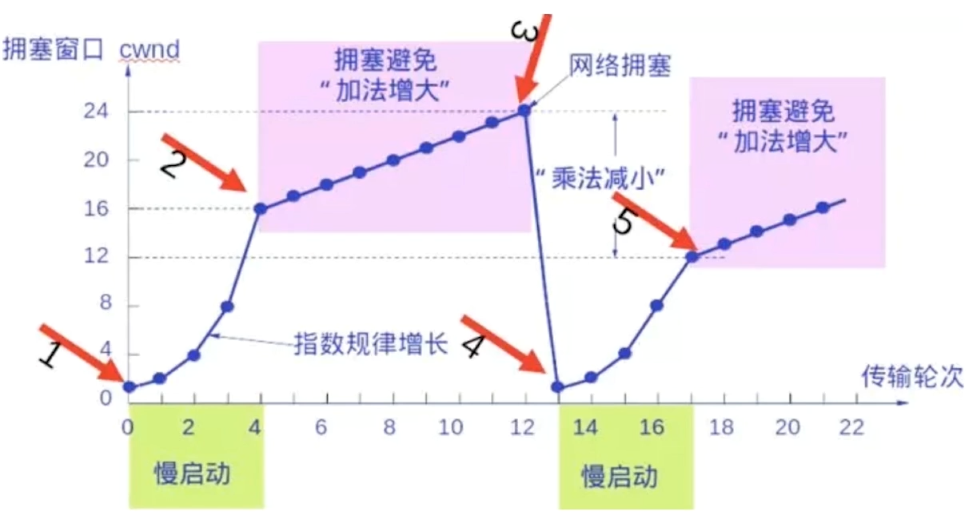
快速重传和快速恢复¶
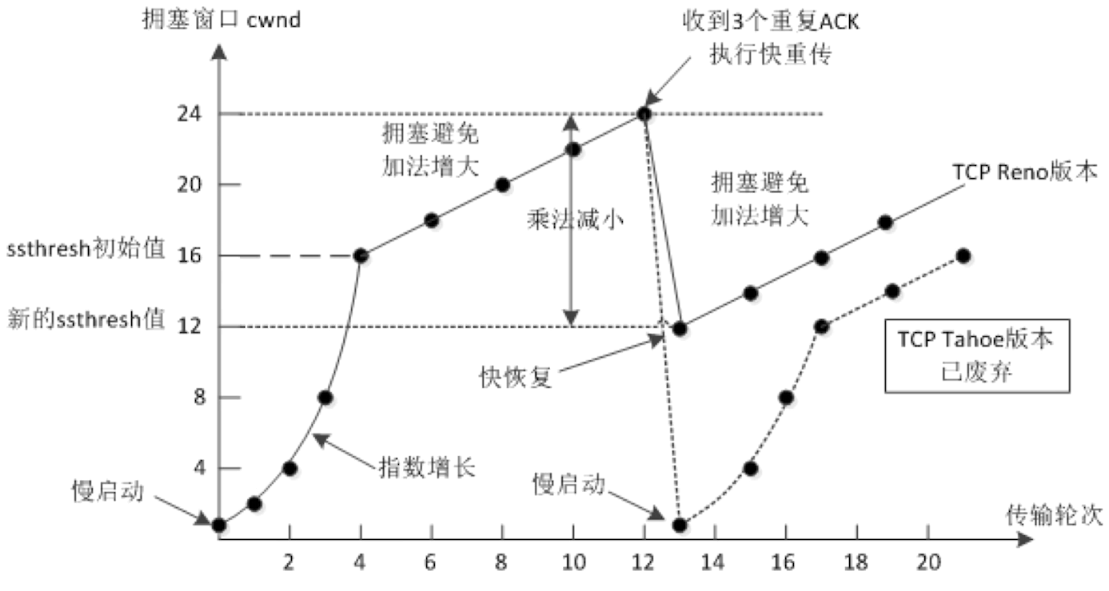
粘包和拆包¶
发生的情况:
- 应用程序写入的数据大于套接字缓冲区大小,这将会发生拆包。
- 应用程序写入数据小于套接字缓冲区大小,网卡将应用多次写入的数据发送到网络上,这将会发生粘包。
- 进行MSS(最大报文长度)大小的TCP分段,当TCP报文长度-TCP头部长度>MSS的时候将会发生拆包。
- 接收方法不及时读取套接字缓冲区数据,这将发生粘包。
数据传输协议¶
- 使用带消息头的协议,头部写入包长度,然后再读取包内容
- 设置定长消息,每次读取定长内容,长度不够时空位补固定字段
- 设置消息边界,服务端从网络流中按消息边界分理出消息内容,一般使用
\n - 专有的协议:json,protobuf
网络代理和网络转发区别¶
- 网络代理
- 用户不直接连接服务器,网络代理去连接。获取数据后返回给用户。
- 网络转发
- 路由器对报文的转发操作,中间可能对数据包修改。
网络代理¶
正向代理¶
是一种客户端的代理技术,帮助客户端访问无法访问的服务资源,可以隐藏用户真实IP。
反向代理¶
是一种服务端的代理技术,帮助服务器做负载均衡、缓存、提供安全校验等,可以隐藏服务器真实IP。
UDP创建过程¶
Server¶
步骤:
- 监听服务器
- 循环读取消息(不创建socket)
- 回复数据
Client¶
步骤:
- 连接服务器
- 发送数据
- 接收数据
TCP创建过程¶
Server¶
步骤:
- 监听端口
- 接受请求,创建套接字连接
- 创建独立协程
- 数据解码
Client¶
步骤:
- 连接服务器
- 将信息写入套接字,数据编码
HTTP创建过程¶
graph LR; HTTP-->Server Server-->创建路由器 Server-->设置路由规则 Server-->创建服务器 Server-->监听端口并提供服务 HTTP-->Client Client-->创建连接池 Client-->创建客户端 Client-->请求数据 Client-->读取内容
Server¶
主要结构体:
type ServeMux struct {
mu sync.RWMutex
m map[string]muxEntry
es []muxEntry // slice of entries sorted from longest to shortest.
hosts bool // whether any patterns contain hostnames
}
type muxEntry struct {
h Handler
pattern string
}
type Handler interface {
ServeHTTP(ResponseWriter, *Request)
}步骤:
- 创建路由器 http.NewServeMux
- 设置路由规则 http.HandleFunc->http.Handle
- 创建服务器 http.Server
- 监听端口并提供服务 http.Server.ListenAndServe->http.server.Serve->http.Accept()->http.newConn->go c.serve->mux.ServeHTTP0>mux.Handler®->mux.handler(r.host,r.URL.Path)->mux.match(path)->v,ok:=mux.m[path]
Client¶
主要结构体: http.Client->Timeout && Transport type RoundTripper interface
步骤:
- 创建连接池 http.Transport
- 创建客户端 http.Client
- 请求数据 func(c *Client) Get(url string)->c.DO(req)->c.do(req)->c.send(req,deadline)->send(req,c.transport(),deadline)->resq,err=rt.RoundTrip(req)&&func(t *Transport)roundTrip(req *Request)
- 读取数据
Transport¶
type Transport struct {
idleMu sync.Mutex
closeIdle bool // user has requested to close all idle conns
idleConn map[connectMethodKey][]*persistConn // most recently used at end
idleConnWait map[connectMethodKey]wantConnQueue // waiting getConns
...
}
type connectMethodKey struct {
proxy, scheme, addr string
onlyH1 bool
}persistConn¶
type persistConn struct {
br *bufio.Reader // from conn
bw *bufio.Writer // to conn
reqch chan requestAndChan // written by roundTrip; read by readLoop
writech chan writeRequest // written by roundTrip; read by writeLoop
...
}RoundTrip流程¶
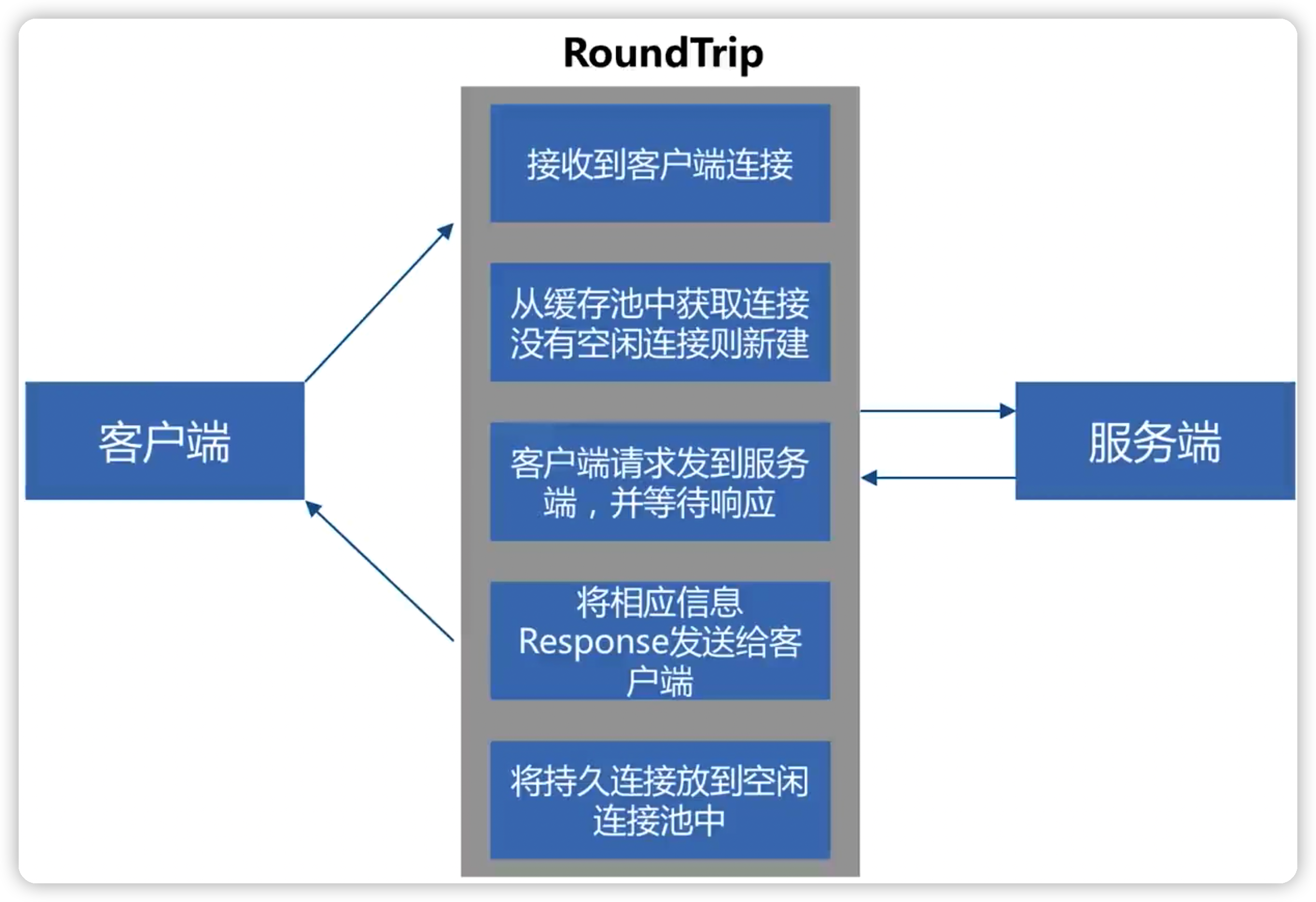
超时时间¶

// 创建连接池
transport := &http.Transport{
DialContext: (&net.Dialer{
Timeout: 30 * time.Second, //连接超时
KeepAlive: 30 * time.Second, //探活时间
}).DialContext,
MaxIdleConns: 100, //最大空闲连接
IdleConnTimeout: 90 * time.Second, //空闲超时时间
TLSHandshakeTimeout: 10 * time.Second, //tls握手超时时间
ExpectContinueTimeout: 1 * time.Second, //100-continue状态码超时时间
}
// 创建客户端
client := &http.Client{
Timeout: time.Second * 30, //请求超时时间
Transport: transport,
}网络代理¶
网络代理 v.s 网络转发:
- 网络代理:用户不直接连接服务器,网络代理去连接。获取数据后返回给用户。
- 网络转发:是路由器对报文的转发操作,中间可能堆数据包修改。
正向代理¶
正向代理:是一种客户端的代理技术。帮助客户端访问无法访问的服务资源,可以隐藏用户真实IP。
- 代理接收客户端请求,复制原请求对象,并根据数据配置新请求各种参数
- 把新请求发送到真实服务端,并接收到服务器返回
- 代理服务器相应做一些处理,然后返回给客户端
http代理¶
import (
"fmt"
"io"
"net"
"net/http"
"strings"
)
type Pxy struct{}
func (p *Pxy) ServeHTTP(rw http.ResponseWriter, req *http.Request) {
fmt.Printf("Received request %s %s %s\n", req.Method, req.Host, req.RemoteAddr)
transport := http.DefaultTransport
// step 1,浅拷贝对象,然后就再新增属性数据
outReq := new(http.Request)
*outReq = *req
if clientIP, _, err := net.SplitHostPort(req.RemoteAddr); err == nil {
if prior, ok := outReq.Header["X-Forwarded-For"]; ok {
clientIP = strings.Join(prior, ", ") + ", " + clientIP
}
outReq.Header.Set("X-Forwarded-For", clientIP)
}
// step 2, 请求下游
res, err := transport.RoundTrip(outReq)
if err != nil {
rw.WriteHeader(http.StatusBadGateway)
return
}
// step 3, 把下游请求内容返回给上游
for key, value := range res.Header {
for _, v := range value {
rw.Header().Add(key, v)
}
}
rw.WriteHeader(res.StatusCode)
io.Copy(rw, res.Body)
res.Body.Close()
}
func main() {
fmt.Println("Serve on :8080")
http.Handle("/", &Pxy{})
http.ListenAndServe("0.0.0.0:8080", nil)
}sock5代理¶
反向代理¶
反向代理:是一种服务端的代理技术,帮助服务器做负载均衡、缓存、提供安全校验等,可以隐藏服务器真实IP。
- 代理接受客户端请求,更改请求结构体信息
- 通过一定的负载均衡算法获取下游服务地址
- 把请求发送给下游服务器,并获取返回内容
- 对返回内容做一些处理,然后返回给客户端
http代理¶
Go内置了httputil.ReverseProxy类型。内置httputil.NewSingleHostReverseProxy。可以按照其实现自己实现。
简单版:
import (
"bufio"
"log"
"net/http"
"net/url"
)
var (
proxy_addr = "http://127.0.0.1:2003"
port = "2002"
)
func handler(w http.ResponseWriter, r *http.Request) {
//step 1 解析代理地址,并更改请求体的协议和主机
proxy, err := url.Parse(proxy_addr)
r.URL.Scheme = proxy.Scheme
r.URL.Host = proxy.Host
//step 2 请求下游
transport := http.DefaultTransport
resp, err := transport.RoundTrip(r)
if err != nil {
log.Print(err)
return
}
//step 3 把下游请求内容返回给上游
for k, vv := range resp.Header {
for _, v := range vv {
w.Header().Add(k, v)
}
}
defer resp.Body.Close()
bufio.NewReader(resp.Body).WriteTo(w)
}
func main() {
http.HandleFunc("/", handler)
log.Println("Start serving on port " + port)
err := http.ListenAndServe(":"+port, nil)
if err != nil {
log.Fatal(err)
}
}ReverseProxy的特殊StatusCode¶
- 100:目前一切正常,客户端可以继续请求
- 客户端Post的数据大于1024字节的时候
- 客户端需要先发送一个请求,包含一个
Expect:100-continue,询问服务端是否愿意接收数据 - 接收到服务端返回的100-continue应答之后,返回100状态,把数据Post到服务端
- 相关策略
- 客户端策略
- 如果客户端有 post 数据要上传,可以考虑使用 100-continue 协议。在请求头中加入 {“Expect”:”100-continue”}
- 如果没有 post 数据,不能使用 100-continue 协议,因为这会让服务端造成误解。
- 并不是所有的 Server 都会正确实现 100-continue 协议,如果 Client 发送 Expect:100-continue 消息后,在 timeout 时间内无响应,Client 需要立马上传 post 数据。
- 有些 Server 会错误实现 100-continue 协议,在不需要此协议时返回 100,此时客户端应该忽略。
- 服务端策略
- 正确情况下,收到请求后,返回 100 或错误码。
- 如果在发送 100-continue 前收到了 post 数据(客户端提前发送 post 数据),则不发送 100 响应码(略去)。
- 客户端策略
- 101:服务端发送给客户端升级协议的请求
ReverseProxy的特殊Header头¶
- 特殊Header头
- X-Forwarded-For
- 记录最后直连实际服务器之前的整个代理过程
- 可能被伪造
- X-Real-IP
- 请求实际服务器的IP
- 每过一层代理都会被覆盖掉,只需第一代理设置转发
- Connection
- TE
- Trailer
- X-Forwarded-For
- 第一代理除去标准的逐段传输头
ReverseProxy¶
type ReverseProxy struct {
// 控制器必须是一个函数,函数内部可以堆请求进行修改
Director func(*http.Request)
// The transport used to perform proxy requests.
// If nil, http.DefaultTransport is used.
// 连接池
Transport http.RoundTripper
// FlushInterval specifies the flush interval
// to flush to the client while copying the
// response body.
// If zero, no periodic flushing is done.
// A negative value means to flush immediately
// after each write to the client.
// The FlushInterval is ignored when ReverseProxy
// recognizes a response as a streaming response, or
// if its ContentLength is -1; for such responses, writes
// are flushed to the client immediately.
// 刷新到客户端的刷新间隔
FlushInterval time.Duration
// ErrorLog specifies an optional logger for errors
// that occur when attempting to proxy the request.
// If nil, logging is done via the log package's standard logger.
// 错误记录器
ErrorLog *log.Logger
// BufferPool optionally specifies a buffer pool to
// get byte slices for use by io.CopyBuffer when
// copying HTTP response bodies.
// 定义缓冲池,在复制http响应时使用,用以提高请求效率
BufferPool BufferPool
// ModifyResponse is an optional function that modifies the
// Response from the backend. It is called if the backend
// returns a response at all, with any HTTP status code.
// If the backend is unreachable, the optional ErrorHandler is
// called without any call to ModifyResponse.
//
// If ModifyResponse returns an error, ErrorHandler is called
// with its error value. If ErrorHandler is nil, its default
// implementation is used.
// 修改response函数
ModifyResponse func(*http.Response) error
// ErrorHandler is an optional function that handles errors
// reaching the backend or errors from ModifyResponse.
//
// If nil, the default is to log the provided error and return
// a 502 Status Bad Gateway response.
// 错误处理回调函数,如果为nil时,则遇到错误会显示502
ErrorHandler func(http.ResponseWriter, *http.Request, error)
}
func (p *ReverseProxy) ServeHTTP(rw http.ResponseWriter, req *http.Request) {
transport := p.Transport
if transport == nil {
transport = http.DefaultTransport
}
// 验证请求是否终止
ctx := req.Context()
if ctx.Done() != nil {
// CloseNotifier predates context.Context, and has been
// entirely superseded by it. If the request contains
// a Context that carries a cancellation signal, don't
// bother spinning up a goroutine to watch the CloseNotify
// channel (if any).
//
// If the request Context has a nil Done channel (which
// means it is either context.Background, or a custom
// Context implementation with no cancellation signal),
// then consult the CloseNotifier if available.
} else if cn, ok := rw.(http.CloseNotifier); ok {
var cancel context.CancelFunc
ctx, cancel = context.WithCancel(ctx)
defer cancel()
notifyChan := cn.CloseNotify()
go func() {
select {
case <-notifyChan:
cancel()
case <-ctx.Done():
}
}()
}
// 设置请求ctx信息
outreq := req.Clone(ctx)
if req.ContentLength == 0 {
outreq.Body = nil // Issue 16036: nil Body for http.Transport retries
}
if outreq.Body != nil {
// Reading from the request body after returning from a handler is not
// allowed, and the RoundTrip goroutine that reads the Body can outlive
// this handler. This can lead to a crash if the handler panics (see
// Issue 46866). Although calling Close doesn't guarantee there isn't
// any Read in flight after the handle returns, in practice it's safe to
// read after closing it.
defer outreq.Body.Close()
}
// 深拷贝header
if outreq.Header == nil {
outreq.Header = make(http.Header) // Issue 33142: historical behavior was to always allocate
}
// 修改req
p.Director(outreq)
outreq.Close = false
// Upgrade头的特殊处理
reqUpType := upgradeType(outreq.Header)
if !ascii.IsPrint(reqUpType) {
p.getErrorHandler()(rw, req, fmt.Errorf("client tried to switch to invalid protocol %q", reqUpType))
return
}
removeConnectionHeaders(outreq.Header)
// Remove hop-by-hop headers to the backend. Especially
// important is "Connection" because we want a persistent
// connection, regardless of what the client sent to us.
// 删除后端的逐段标题
for _, h := range hopHeaders {
outreq.Header.Del(h)
}
// Issue 21096: tell backend applications that care about trailer support
// that we support trailers. (We do, but we don't go out of our way to
// advertise that unless the incoming client request thought it was worth
// mentioning.) Note that we look at req.Header, not outreq.Header, since
// the latter has passed through removeConnectionHeaders.
if httpguts.HeaderValuesContainsToken(req.Header["Te"], "trailers") {
outreq.Header.Set("Te", "trailers")
}
// After stripping all the hop-by-hop connection headers above, add back any
// necessary for protocol upgrades, such as for websockets.
if reqUpType != "" {
outreq.Header.Set("Connection", "Upgrade")
outreq.Header.Set("Upgrade", reqUpType)
}
// 追加clint IP信息
if clientIP, _, err := net.SplitHostPort(req.RemoteAddr); err == nil {
// If we aren't the first proxy retain prior
// X-Forwarded-For information as a comma+space
// separated list and fold multiple headers into one.
prior, ok := outreq.Header["X-Forwarded-For"]
omit := ok && prior == nil // Issue 38079: nil now means don't populate the header
if len(prior) > 0 {
clientIP = strings.Join(prior, ", ") + ", " + clientIP
}
if !omit {
outreq.Header.Set("X-Forwarded-For", clientIP)
}
}
// 向下游请求数据
res, err := transport.RoundTrip(outreq)
if err != nil {
p.getErrorHandler()(rw, outreq, err)
return
}
// Deal with 101 Switching Protocols responses: (WebSocket, h2c, etc)
// 处理升级协议请求
if res.StatusCode == http.StatusSwitchingProtocols {
if !p.modifyResponse(rw, res, outreq) {
return
}
p.handleUpgradeResponse(rw, outreq, res)
return
}
// 移除逐段头部
removeConnectionHeaders(res.Header)
for _, h := range hopHeaders {
res.Header.Del(h)
}
// 修改返回数据
if !p.modifyResponse(rw, res, outreq) {
return
}
// 拷贝头部信息
copyHeader(rw.Header(), res.Header)
// The "Trailer" header isn't included in the Transport's response,
// at least for *http.Transport. Build it up from Trailer.
announcedTrailers := len(res.Trailer)
if announcedTrailers > 0 {
trailerKeys := make([]string, 0, len(res.Trailer))
for k := range res.Trailer {
trailerKeys = append(trailerKeys, k)
}
rw.Header().Add("Trailer", strings.Join(trailerKeys, ", "))
}
// 写入状态码
rw.WriteHeader(res.StatusCode)
// 周期刷新内容到response
err = p.copyResponse(rw, res.Body, p.flushInterval(res))
if err != nil {
defer res.Body.Close()
// Since we're streaming the response, if we run into an error all we can do
// is abort the request. Issue 23643: ReverseProxy should use ErrAbortHandler
// on read error while copying body.
if !shouldPanicOnCopyError(req) {
p.logf("suppressing panic for copyResponse error in test; copy error: %v", err)
return
}
panic(http.ErrAbortHandler)
}
res.Body.Close() // close now, instead of defer, to populate res.Trailer
if len(res.Trailer) > 0 {
// Force chunking if we saw a response trailer.
// This prevents net/http from calculating the length for short
// bodies and adding a Content-Length.
if fl, ok := rw.(http.Flusher); ok {
fl.Flush()
}
}
if len(res.Trailer) == announcedTrailers {
copyHeader(rw.Header(), res.Trailer)
return
}
for k, vv := range res.Trailer {
k = http.TrailerPrefix + k
for _, v := range vv {
rw.Header().Add(k, v)
}
}
}修改response后记得更新响应头中的 Content-Length以及响应体中ContentLength属性。
func (p *ReverseProxy)ServerHTTP主要步骤如下:
- 验证是否请求终止
- 设置请求ctx信息
- 深拷贝header
- 修改req
- Upgrade头的特殊处理
- 追加clientIp信息
- 向下游请求数据
- 处理升级协议请求
- 移除逐段头部
- 修改返回内容
- 拷贝头部的数据
- 写入状态码
- 周期刷新内容到response
Connection¶
- 标记请求发起方与第一代理的状态
- 决定当前事务完成后,是否会关闭网络
- Connection:keep-alive 不关闭网络
- Connection:close 关闭网络
- Connection:upgrade 协议升级
TE¶
TE是requesy_header,表示希望使用的传输编码类型。
如:TE:trailers,deflate;q=0.5表示,期望在采用分块传输编码响应中接收挂载字段,zlib编码,0.5优先级排序。
Trailer¶
Trailer是response header,允许发送方在消息后面添加额外的元信息。
如:Trailer:Expires表示Expires将出现在分块信息的结尾。
去除逐段传输头¶
代理过程中上述只发生在客户端和第一代理中。因此第一代理需要除去标准的逐段传输头(hop-by-hop)
- 逐段传输头都需要在Connection头中列出
- 第一代理必须处理它们且不转发
- 逐段传输头:
Keep-Alive,Transfer-Encoding,TE,Connection,Trailer,Upgrade,Proxy-Authorization,Proxy-Authenticate
socks5代理¶
负载均衡¶
随机负载均衡¶
import (
"errors"
"fmt"
"math/rand"
"strings"
)
type RandomBalance struct {
curIndex int
rss []string
//观察主体
conf LoadBalanceConf
}
func (r *RandomBalance) Add(params ...string) error {
if len(params) == 0 {
return errors.New("param len 1 at least")
}
addr := params[0]
r.rss = append(r.rss, addr)
return nil
}
func (r *RandomBalance) Next() string {
if len(r.rss) == 0 {
return ""
}
r.curIndex = rand.Intn(len(r.rss))
return r.rss[r.curIndex]
}
func (r *RandomBalance) Get(key string) (string, error) {
return r.Next(), nil
}
func (r *RandomBalance) SetConf(conf LoadBalanceConf) {
r.conf = conf
}
func (r *RandomBalance) Update() {
if conf, ok := r.conf.(*LoadBalanceZkConf); ok {
fmt.Println("Update get conf:", conf.GetConf())
r.rss = []string{}
for _, ip := range conf.GetConf() {
r.Add(strings.Split(ip, ",")...)
}
}
if conf, ok := r.conf.(*LoadBalanceCheckConf); ok {
fmt.Println("Update get conf:", conf.GetConf())
r.rss = nil
for _, ip := range conf.GetConf() {
r.Add(strings.Split(ip, ",")...)
}
}
}轮询负载均衡¶
import (
"errors"
"fmt"
"strings"
)
type RoundRobinBalance struct {
curIndex int
rss []string
//观察主体
conf LoadBalanceConf
}
func (r *RoundRobinBalance) Add(params ...string) error {
if len(params) == 0 {
return errors.New("param len 1 at least")
}
addr := params[0]
r.rss = append(r.rss, addr)
return nil
}
func (r *RoundRobinBalance) Next() string {
if len(r.rss) == 0 {
return ""
}
lens := len(r.rss) //5
if r.curIndex >= lens {
r.curIndex = 0
}
curAddr := r.rss[r.curIndex]
r.curIndex = (r.curIndex + 1) % lens
return curAddr
}
func (r *RoundRobinBalance) Get(key string) (string, error) {
return r.Next(), nil
}
func (r *RoundRobinBalance) SetConf(conf LoadBalanceConf) {
r.conf = conf
}
func (r *RoundRobinBalance) Update() {
if conf, ok := r.conf.(*LoadBalanceZkConf); ok {
fmt.Println("Update get conf:", conf.GetConf())
r.rss = []string{}
for _, ip := range conf.GetConf() {
r.Add(strings.Split(ip, ",")...)
}
}
if conf, ok := r.conf.(*LoadBalanceCheckConf); ok {
fmt.Println("Update get conf:", conf.GetConf())
r.rss = nil
for _, ip := range conf.GetConf() {
r.Add(strings.Split(ip, ",")...)
}
}
}加权轮询负载均衡¶
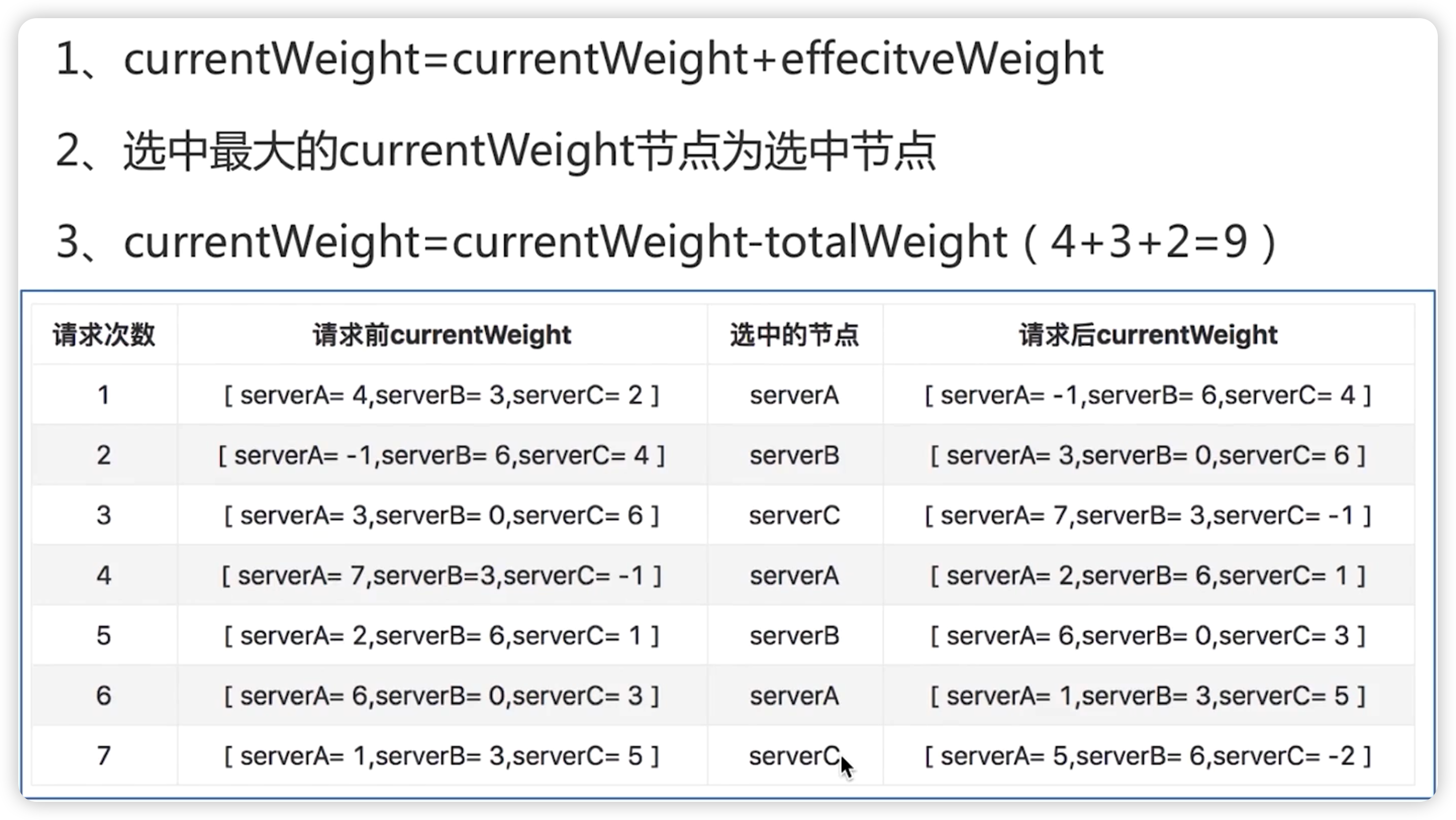
注意这里没有考虑调用下游失败的情况,实际环境中会因为下游失败导致effectiveWeight减少。
import (
"errors"
"fmt"
"strconv"
"strings"
)
type WeightRoundRobinBalance struct {
curIndex int
rss []*WeightNode
rsw []int
//观察主体
conf LoadBalanceConf
}
type WeightNode struct {
addr string
weight int //权重值
currentWeight int //节点当前权重
effectiveWeight int //有效权重
}
func (r *WeightRoundRobinBalance) Add(params ...string) error {
if len(params) != 2 {
return errors.New("param len need 2")
}
parInt, err := strconv.ParseInt(params[1], 10, 64)
if err != nil {
return err
}
node := &WeightNode{addr: params[0], weight: int(parInt)}
node.effectiveWeight = node.weight
r.rss = append(r.rss, node)
return nil
}
func (r *WeightRoundRobinBalance) Next() string {
total := 0
var best *WeightNode
for i := 0; i < len(r.rss); i++ {
w := r.rss[i]
//step 1 统计所有有效权重之和
total += w.effectiveWeight
//step 2 变更节点临时权重为的节点临时权重+节点有效权重
w.currentWeight += w.effectiveWeight
//step 3 有效权重默认与权重相同,通讯异常时-1, 通讯成功+1,直到恢复到weight大小
if w.effectiveWeight < w.weight {
w.effectiveWeight++
}
//step 4 选择最大临时权重点节点
if best == nil || w.currentWeight > best.currentWeight {
best = w
}
}
if best == nil {
return ""
}
//step 5 变更临时权重为 临时权重-有效权重之和
best.currentWeight -= total
return best.addr
}
func (r *WeightRoundRobinBalance) Get(key string) (string, error) {
return r.Next(), nil
}
func (r *WeightRoundRobinBalance) SetConf(conf LoadBalanceConf) {
r.conf = conf
}
func (r *WeightRoundRobinBalance) Update() {
if conf, ok := r.conf.(*LoadBalanceZkConf); ok {
fmt.Println("WeightRoundRobinBalance get conf:", conf.GetConf())
r.rss = nil
for _, ip := range conf.GetConf() {
r.Add(strings.Split(ip, ",")...)
}
}
if conf, ok := r.conf.(*LoadBalanceCheckConf); ok {
fmt.Println("WeightRoundRobinBalance get conf:", conf.GetConf())
r.rss = nil
for _, ip := range conf.GetConf() {
r.Add(strings.Split(ip, ",")...)
}
}
}一致性负载均衡¶
import (
"errors"
"fmt"
"hash/crc32"
"sort"
"strconv"
"strings"
"sync"
)
type Hash func(data []byte) uint32
type UInt32Slice []uint32
func (s UInt32Slice) Len() int {
return len(s)
}
func (s UInt32Slice) Less(i, j int) bool {
return s[i] < s[j]
}
func (s UInt32Slice) Swap(i, j int) {
s[i], s[j] = s[j], s[i]
}
type ConsistentHashBanlance struct {
mux sync.RWMutex
hash Hash
replicas int //复制因子
keys UInt32Slice //已排序的节点hash切片
hashMap map[uint32]string //节点哈希和Key的map,键是hash值,值是节点key
//观察主体
conf LoadBalanceConf
}
func NewConsistentHashBanlance(replicas int, fn Hash) *ConsistentHashBanlance {
m := &ConsistentHashBanlance{
replicas: replicas,
hash: fn,
hashMap: make(map[uint32]string),
}
if m.hash == nil {
//最多32位,保证是一个2^32-1环
m.hash = crc32.ChecksumIEEE
}
return m
}
// 验证是否为空
func (c *ConsistentHashBanlance) IsEmpty() bool {
return len(c.keys) == 0
}
// Add 方法用来添加缓存节点,参数为节点key,比如使用IP
func (c *ConsistentHashBanlance) Add(params ...string) error {
if len(params) == 0 {
return errors.New("param len 1 at least")
}
addr := params[0]
c.mux.Lock()
defer c.mux.Unlock()
// 结合复制因子计算所有虚拟节点的hash值,并存入m.keys中,同时在m.hashMap中保存哈希值和key的映射
for i := 0; i < c.replicas; i++ {
hash := c.hash([]byte(strconv.Itoa(i) + addr))
c.keys = append(c.keys, hash)
c.hashMap[hash] = addr
}
// 对所有虚拟节点的哈希值进行排序,方便之后进行二分查找
sort.Sort(c.keys)
return nil
}
// Get 方法根据给定的对象获取最靠近它的那个节点
func (c *ConsistentHashBanlance) Get(key string) (string, error) {
if c.IsEmpty() {
return "", errors.New("node is empty")
}
hash := c.hash([]byte(key))
// 通过二分查找获取最优节点,第一个"服务器hash"值大于"数据hash"值的就是最优"服务器节点"
idx := sort.Search(len(c.keys), func(i int) bool { return c.keys[i] >= hash })
// 如果查找结果 大于 服务器节点哈希数组的最大索引,表示此时该对象哈希值位于最后一个节点之后,那么放入第一个节点中
if idx == len(c.keys) {
idx = 0
}
c.mux.RLock()
defer c.mux.RUnlock()
return c.hashMap[c.keys[idx]], nil
}
func (c *ConsistentHashBanlance) SetConf(conf LoadBalanceConf) {
c.conf = conf
}
func (c *ConsistentHashBanlance) Update() {
if conf, ok := c.conf.(*LoadBalanceZkConf); ok {
fmt.Println("Update get conf:", conf.GetConf())
c.keys = nil
c.hashMap = nil
for _, ip := range conf.GetConf() {
c.Add(strings.Split(ip, ",")...)
}
}
if conf, ok := c.conf.(*LoadBalanceCheckConf); ok {
fmt.Println("Update get conf:", conf.GetConf())
c.keys = nil
c.hashMap = map[uint32]string{}
for _, ip := range conf.GetConf() {
c.Add(strings.Split(ip, ",")...)
}
}
}Tip¶
代码中合理运用swagger可以快速生成对应的测试接口文档。
使用Validation和translations可以校验参数,针对特殊的校验可以在参数的结构体中添加自定义校验方法,并将方案实现在验证器中,对用路由注册时添加验证器中间件即可。



